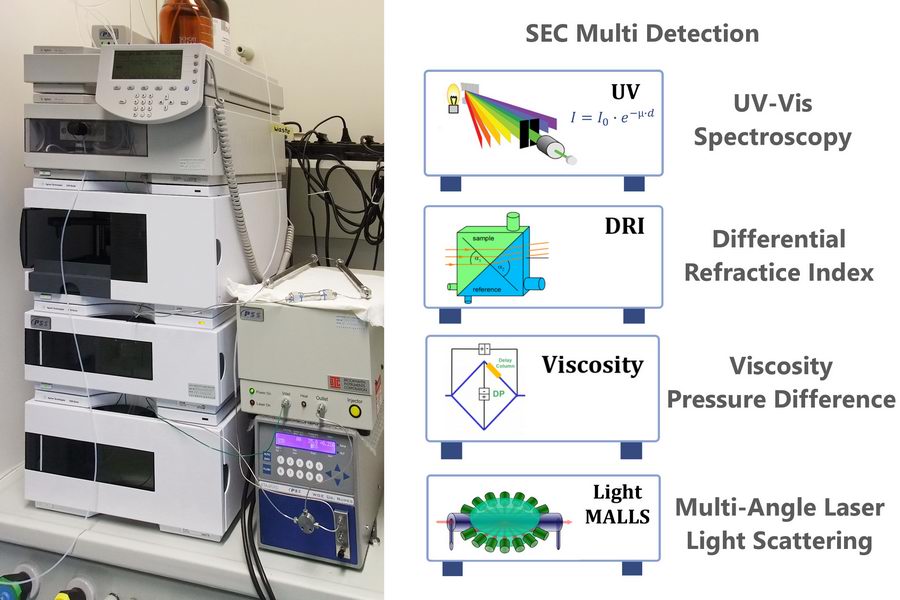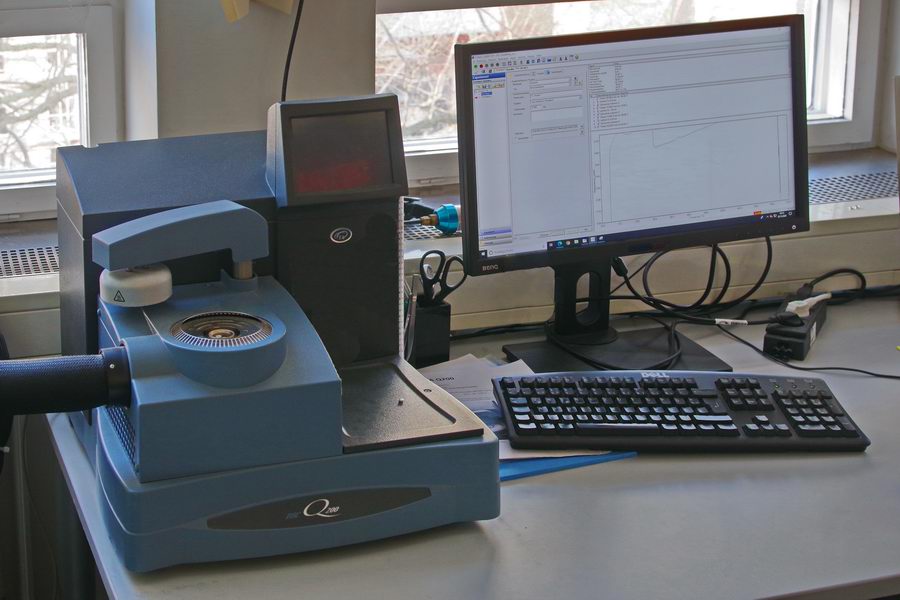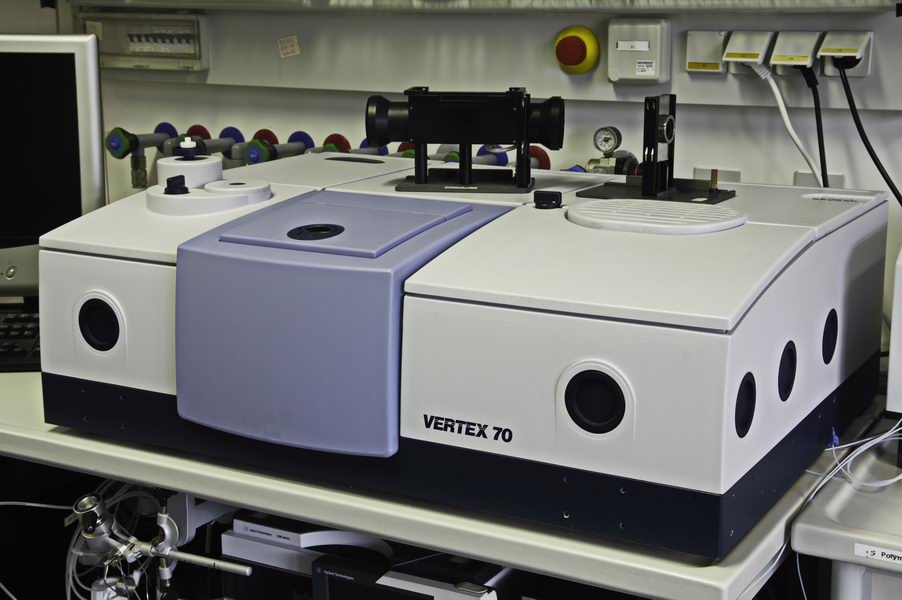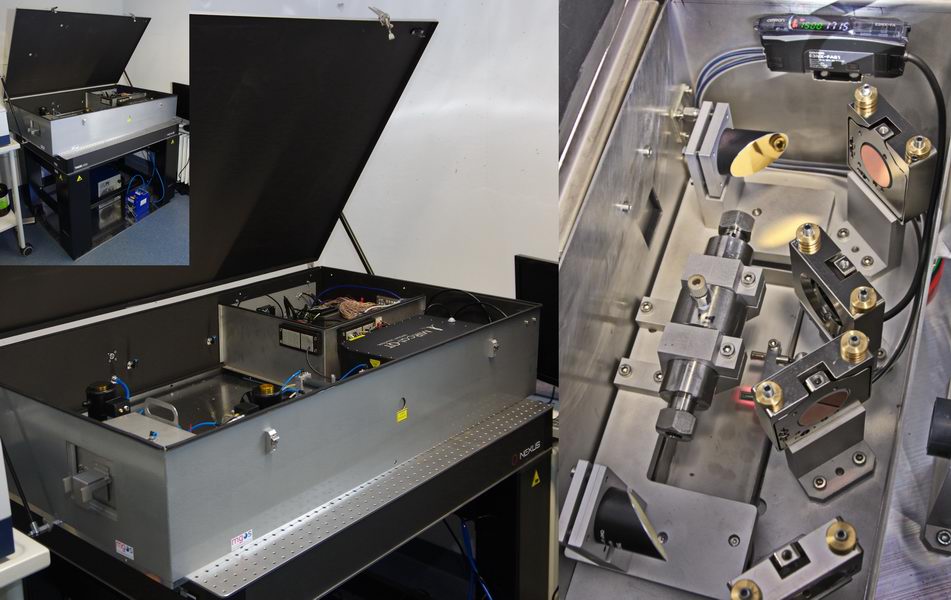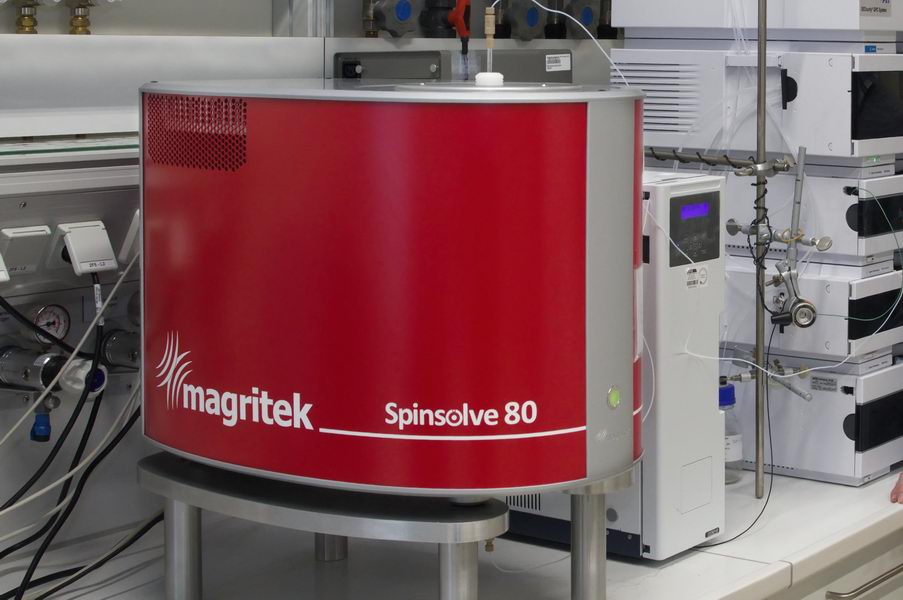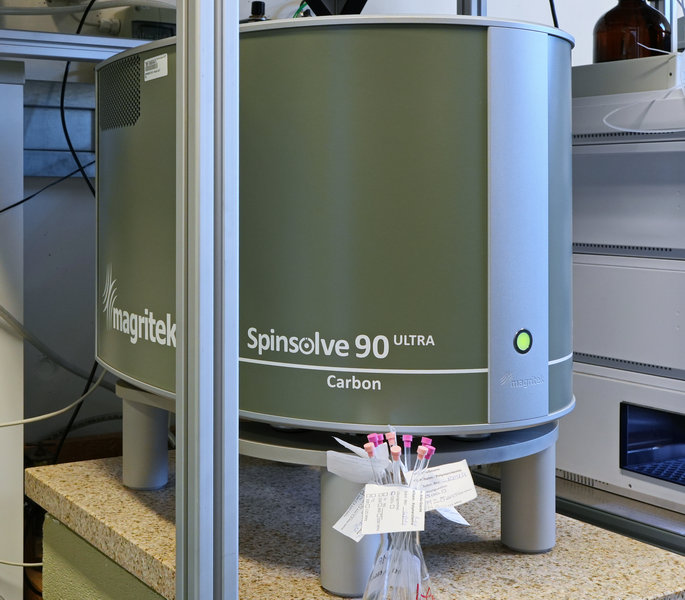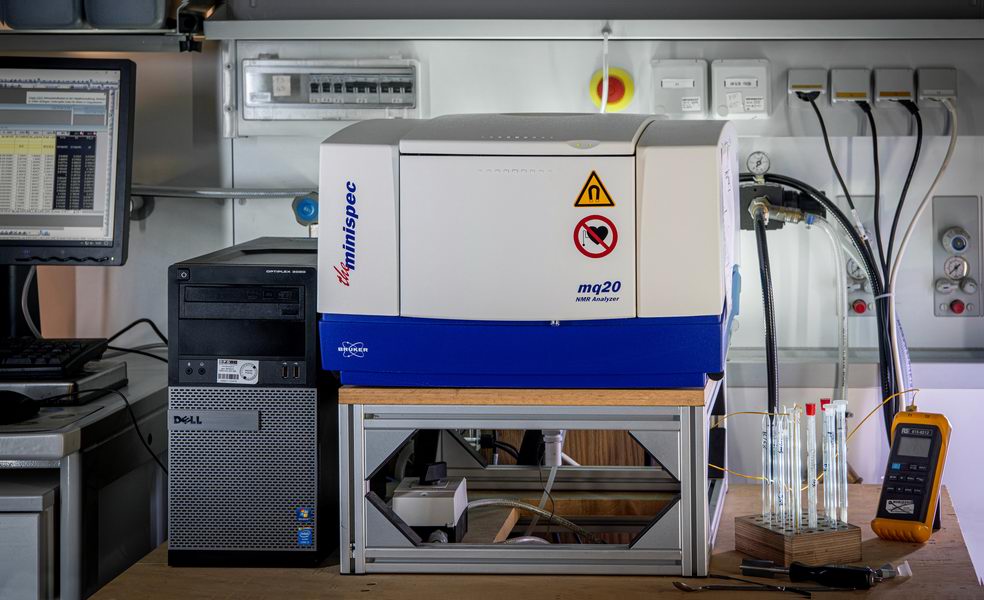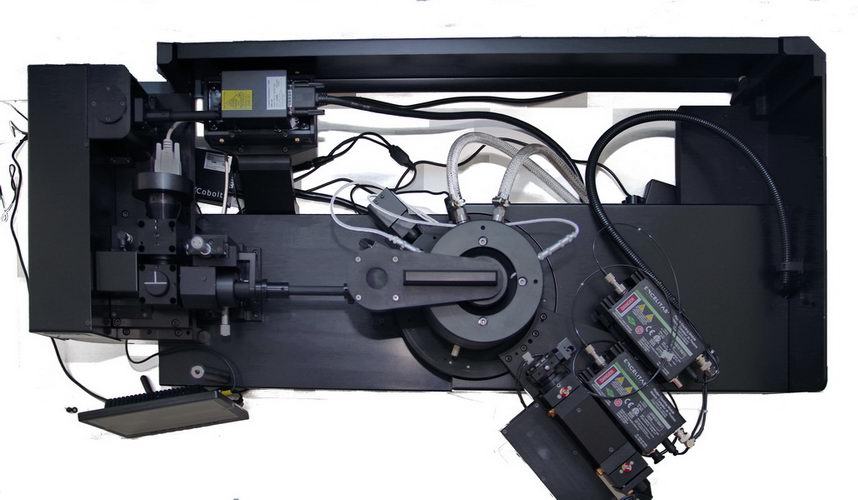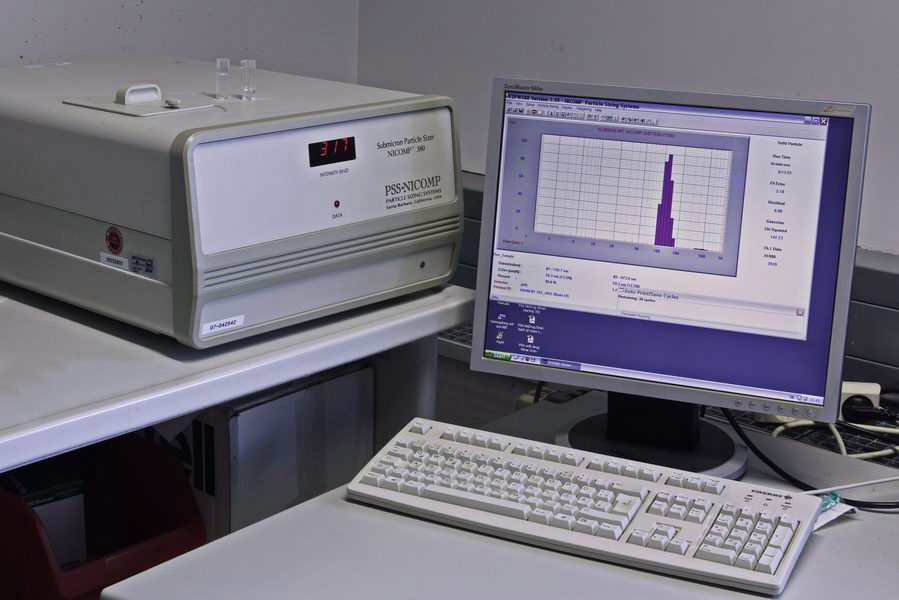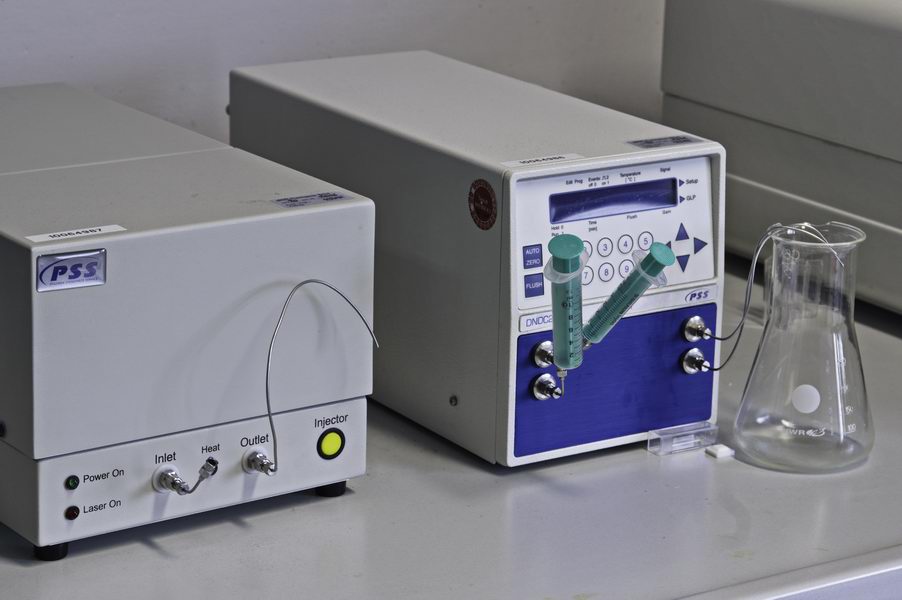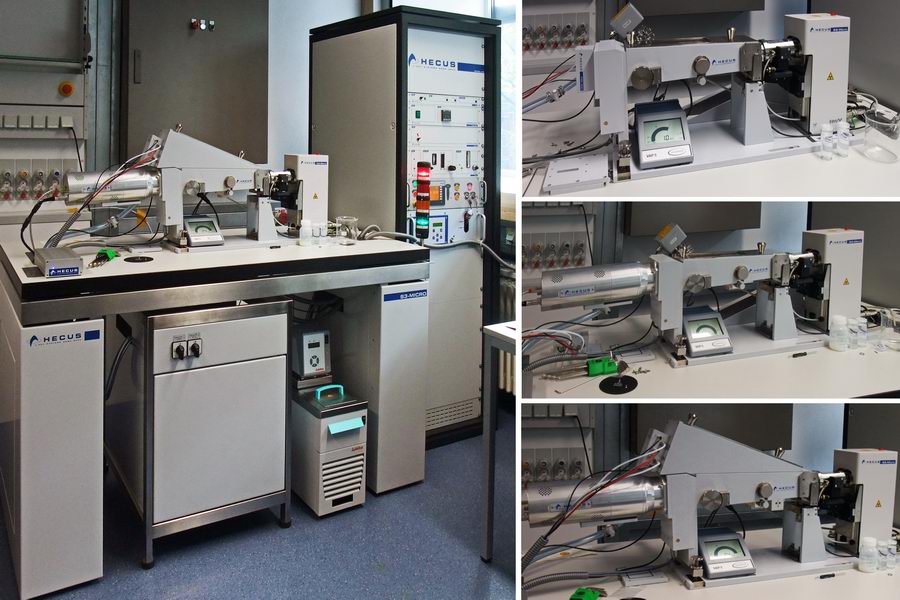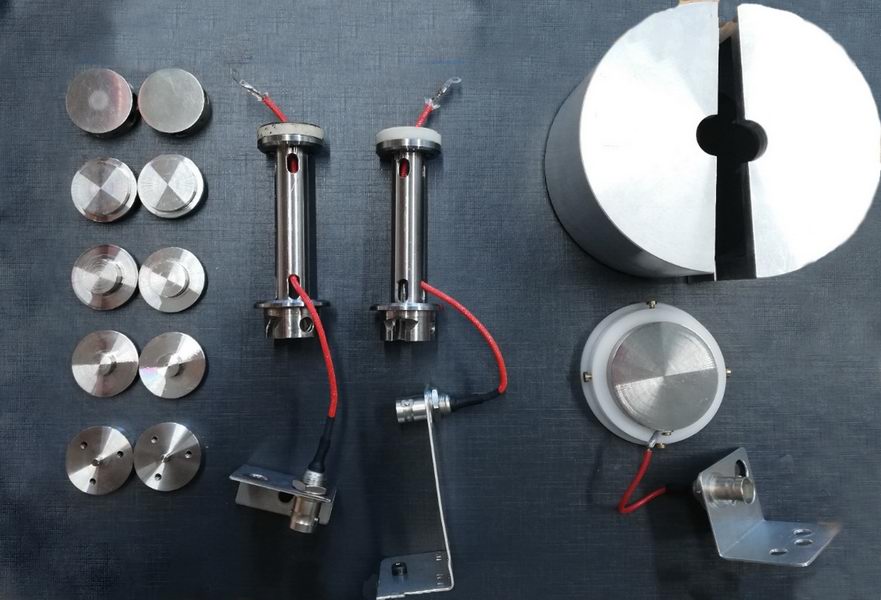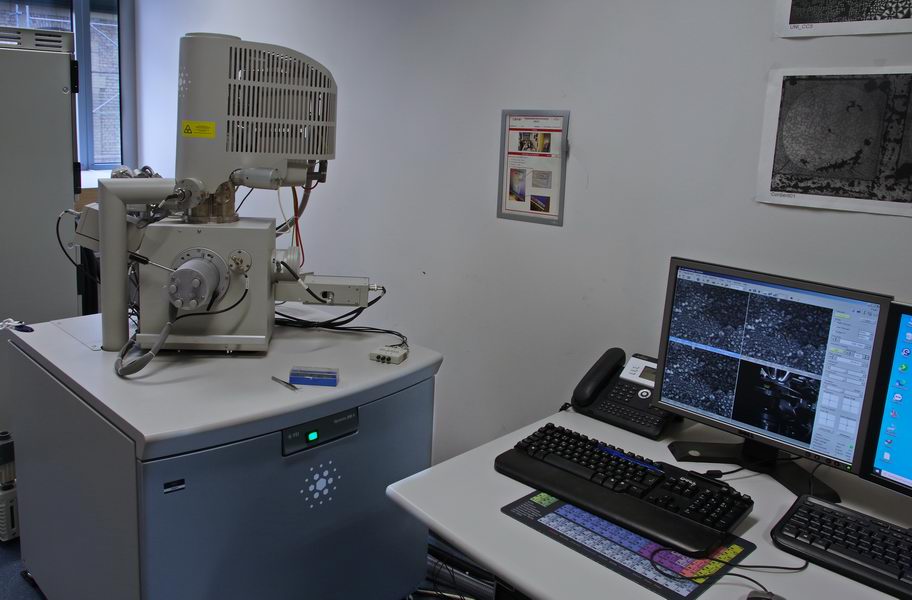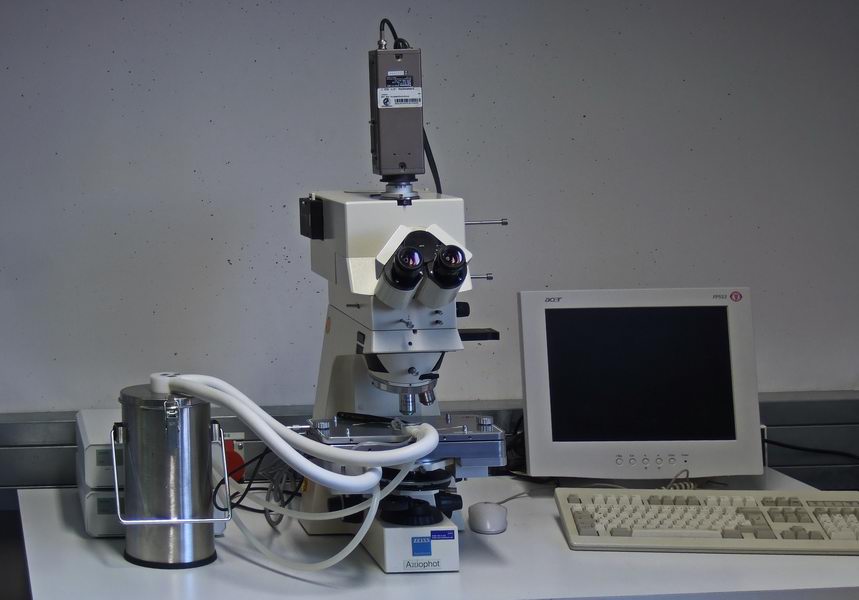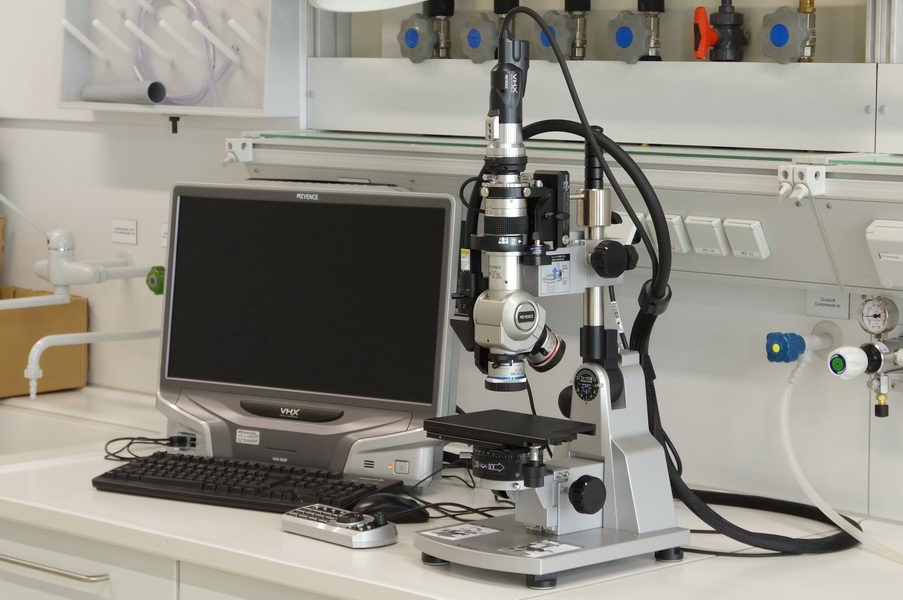| Equipment list divided into different areas (short device descriptions in English) (here link to the complete list of all devices) |
SEC (Size Exclusion Chromatography, Multi-Detection)
Size Exclusion chromatography, Multi Detection
Agilent 1200 series, Polymer standard service (PSS)
Contact Person:
Size exclusion chromatography (german: Gelpermeationschromatographie, GPC) Calibration versus PS-Standards, solvent normally THF. Two Columns two achieve a broad range in molecular weight, accesibble is 500 g/mol to 3.000.000 g/mol.
Triple Detection: Standard concentration detector either UV or RI-Detector, plus viscosity detector and MALLS-detector (multi-angle-laser-light-scattering) for measurement of unknown polymers or absolute molar mass determination for samples with no available calibration curve, e.g. polymers with complex topology.
DSC (Differential Scanning Calorimetrie)
FTIR (Fourier-Transform Infrared Spectroscopy)
FT-IR (Fourier-Transform IR Spectroscopy)
Vertex 70, Bruker
Contact person: Pollard, Micheal
Bruker Vertex 70 for FT-IR spectroscopy equipped with several detectors for MIR- and NIR-spectroscopy with high spectral resolution and possibility for time resolved spectroscopy.
Sample can be measured as foils, solutions, powder or, with the use ATR-Cyrstals (attenuated total reflection), directly on the surface of Solids.
IR - QCL (Infrared-Laser Spectroscopy)
IR-QCL (Infrared Spectroscopy based on Quantum Cascade Laser)
Self-construction in cooperation with MG Optical solutions and neoplas GmbH
Contact Person: Pollard, Michael
This combination of size exclusion chromatography and IR spectroscopy based on quantum cascade IR lasers (QCL) allows correlated information about molecular size and special chemical groups detected via IR. Due to the high intensity of the QCL-lasers, rare groups are accessible not detecbable in normal FTIR-Spectroscopy.
Application example: Amount of rare functional groups (at the moment: 1 Carbonyl group in a polymer of 500.000 g/mol), in future also planned for determination of endgroups and branching units.
One part of the self-developed 3-dimensional spectroscopy: dim1:Size via SEC, dim2: chemical composition via SEC-FTIR or SEC-NMR, dim3: topology, endgroups via SEC-IR-QCL.
NMR Spectroscopy (Medium Field, 80 MHz)
NMR Spectroscopy (Medium Field, 80 MHz)
Spinsolve 80, Magritek
Contact person: Matz, Markus
The Magritek Spinsolve 80 NMR spectrometer sets a new standard for NMR instruments. The Spinsolve 80 spectrometer provides high quality 1H NMR spectra in seconds and is based on permanent magnets, therefore no liquid nitrogen or helium is needed for the operation. The Sensitivity is high due to the optimization of all components for only 1H NMR Spectra. The main idea for this spectrometer is the usage in combination with GPC as the Magritec is also able to measure samples in flow. With this combination, we plan to build up a two dimensional charaterisation GPC-NMR, with size resolution due to the GPC and chemical information due to the NMR.
NMR Spectroscopy (Medium Field, 90 MHz)
NMR Spectroscopy (Medium Field, 90 MHz)
Spinsolve 90, Magritek
Contact person: Matz, Markus
The Magritek Spinsolve 90 NMR spectrometer (Permanent magnet of 2.1 Tesla) sets a new standard for NMR instruments. Inspite to the Spinsolve 80 spectrometer, we choose a configuration for 13C and 1H-NMR Spectra. In addition, the machine also allows pulsed gradients (ca 0.5 T/m). In Summary, this machine allows classcial 13C and 1H spectra offering a resolution sufficient for typical polymer spectra and a high sensitivity (SN ca. 240:1, 1%). The pulsed gradient allows additional possibilities: Advanced solvent suppression methods in case you want to combine the NMR with a HPLC separation or offering the possibilities to measure many 2D-Spectra, one example is 2D-DOSY offering the posssibility to measure diffusion coefficients and teh the calculation of molecular weight diistribution without the need of a separation by a colum.
NMR Relaxation Spectroscopy (Low Field, 20 MHz)
NMR Relaxation Spectroscopy (Low Field, 20 MHz)
MQ20 (2x), Bruker
Contact person: Matz, Markus
Bruker Minspec mq20 offers determination of molecular mobility on a very small length scale of approximatelly 0-3 Angström via 1H-NMR Relaxation spectroscopy in two different implementations:
a) Standard MQ20 with temperature control for relaxation times measurement to view the dynamics in polymer solutions and melts on a molecular scale
b) Optimized MQ20 with fully digital electronics, special lock system and possibility of shimming, used in a project testing NMR-spectroscopy of polymers with low-field equipment
SLS + DLS (Combined Static and Dynamic Light Scattering)
SLS + DLS (Combined Static and Dynamic Light Scattering)
ALV/CGS-3 Goniometer System, ALV, Germany
Contact Person: Dingenouts, Nico
Static Light scattering for determination of molecular weight, radius of gyration and second virial coefficient High temperature range (up to 90 °C), free selection of angle (Goniometer) and solvent (Quartz cuvettes).
DLS for determination of hydrodynamic radii or aggregation behavior, e.g. for colloids or proteins. Small sample amount, also possible in depolarized scattering mode.
DLS (Dyanmic Light Scattering)
DLS (Dyanmic Light Scattering)
Nicomp 380 DLS, Particle Sizing Systems (PSS)
Contact Person: Dingenouts, Nico
Dynamic Light Scattering Spectrometer Nicomp 380 DLS from Particle Sizing Systems with high sensitive detector and strong laser for small particles R>1nm including
a) multi-angle-option for the necessary extrapolation of hydrodynamic radii of polymers
b) back scattering option for measurement of turbid samples
c) Zeta-Potential measurement for charged samples, e.g. latices charged
SLS + DnDc (Contrast determination for SLS and SEC)
SLS + DnDc (Contrast determination for SLS and SEC)
DnDc2010 & MwA, Brookhaven Instruments
Contact Person: Dingenouts, Nico
DnDC: Measurement of optical contrast, e.g. dn/dc for solutions of polymers allowing a high number of different solvents. Absolute requirement for static light scattering (SLS), also necessary for GPC/MALLS combination measurements.
MwA: Multi-angle laser light detector (MALLS), can be used as dectector in SEC or stand-alone, allows fast determination of a Zimm-Diagramm due to parallel measurement of all scattering angles simutanously.
SAXS (Small angle x-ray scattering)
SAXS (Small angle x-ray scattering)
S3-Micro, Hecus X-ray systems
Contact Person: Dingenouts, Nico
Due to start up money from the Barner-Kowollik group and in a joint effort we are happy to have access to Small-angle X-ray scattering (SAXS) for determination of structure and interaction in solution and ordering in melt and solids, point focus and 2D-Dectection.
Different configurations are availlable: 1D-Gas dectector (high sensitivity and low background) for small angles and unoriented samples, 2D-CCD-detector (high resolution) for oriented samples and a SAXS-WAXS combination using both detectors combined with an extension of the camera body.
Dielectric Spectroscopy
Dielectric Spectroscopy
Dielectric Analyzer, Novocontrol
Contact person: Klein, Christopher
Dielectric spectrometer: Detection of molecular motion under shear Measurement in combination with Rheology (ARES for polymer melts). Measurement is fully integrated in the rheometer, so also a measurement without shear will be performed in the rheometer. The picture therefore show the self-developed equipment to include the dieelctric measruement in a rheological sample holder.
SEM (Scanning electron microscopy)
SEM (Scanning electron microscopy)
FEI Quanta 200 F (Field Electron and Ion Company, FEI)
(seit 2016 Tochtergesellschaft von Thermo Fisher Scientific)
Contact Person: Zeller, Ingrid
SEM (Scanning electron microscopy): Surface and crosssection of materials in high resolution, enlarged images of a variety of specimens, achieving magnifications of over 100000x providing high resolution imaging in a digital format.
Application example foam structures: control the influence of polymer topology and foaming process conditions on the resulting foam properties.
Optical Microscopy (including polarisation microscopy)
Optical Microscopy (including polarisation microscopy)
Zeiss Axiophot, Zeiss
Contact Person: Klein, Christopher
Optical Zeiss Microscope with digital video camera and two specific sample holders for:
- extension table for polymers under shear
- polarisation microscope, typically used for nematic phases in liquid crystals.
Incident Light Microscope (Digital, high magnification up to 2000x)
Incident Light Microscope (Digital, high magnification up to 2000x)
Keyence VHX 900F
Contact Person: Klein, Christopher
Digital microscope for surfaces (incident light microscope) with µm-resolution and an impressiv depth of field due to features as automatic focus stacking. Enlargement rand reaching from 1:1 up to 2000:1. It's the perfect complement to our Zeiss transmission microscope.


